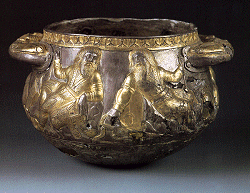George Hinge
|
Herodotus’ image of the Scythians |
|
|
|
|
The Scythians play an important role in Greek literature (from Aristeas, 7th cent. B.C. until Dio Chrysostom, c. 100 A.D.) and science (i.a. in the Hippocratic work Airs, Waters and Places). However, the most important literary source to the Scythian culture is Herodotus Book 4. I studies how Herodotus describes the Scythians as the typical contrast to Greek civilisation and how this image infuates the construction of the Greeks themselves. Some elements of the Herodotean image of the Scythians occur in later Ethnographic descriptions of the Celtic and the Germanic tribes. Therefore, the reality of the image has been questioned. Hartog, an important representative of the so-called ”Liar School”, shows how the Scythian ethnography of Herodotus may be analysed as a coherent narrative, and by virtue of that it is not proper historiography (though, Hartog balanced enough to say that this conclusion lies outsidde the scope of his investigation). It is, however, a typical pitfall of the constructionist approach: to overestimate construction as a concept and at the same time, paradoxically enough, to underestimate the essentiality and continuity of the cultural constructs. Germanic does not disappear as a linguistic category, just beacause the idea about Germanic identity is the product of the encounte of Germanic and Roman culture. The Scythian royla burials do not disappear either, just beacause they are integrated in the Scythian logos of Herodotus. Another question is with which parameters the ancient authors identify this Scythian ethnicity. Herodotus and other sources refer to a Scythian people; however, we are probably not dealing with a people in the modern sense of that word, but with heterogeneous tribes. I have therefore investigated the role of language in Herodotean ethnography. The project resulted in the following articles:
|
 As a research fellow of the
As a research fellow of the